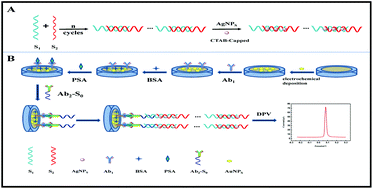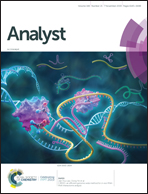DNA concatemer-silver nanoparticles as a signal probe for electrochemical prostate-specific antigen detection†
Abstract
In this study, we report a metallobioassay for ultrasensitive electrochemical detection of prostate-specific antigen (PSA) based on DNA hybridization chain reaction (HCR) for amplifying the signal, which is derived from silver nanoparticles (Ag NPs) on DNA concatemers. The assay mainly consists of primary antibody (Ab1), secondary antibody (Ab2) with primer, and a signal probe. In the presence of PSA, a sandwich structure with DNA concatemers was formed, and numerous Ag NPs were loaded on the DNA concatemers, resulting in a strong signal, which appeared within the applied potential (−0.2 V to 0.3 V) in the phosphate-buffered saline (PBS). Differential pulse voltammetry (DPV) was employed to evaluate the analytical performance. Under optimal conditions, the DPV peak current of Ag NPs at about +0.09 V (vs. SCE) increased linearly as the logarithm of PSA concentration increased from 0.1 pg mL−1 to 75 ng mL−1, and the detection limit of PSA was estimated to be 0.033 pg mL−1 at the signal to noise ratio of 3. In addition, the assay was evaluated with human serum samples, and satisfying results were obtained, indicating that the assay can achieve PSA detection in the serum sample.



 Please wait while we load your content...
Please wait while we load your content...